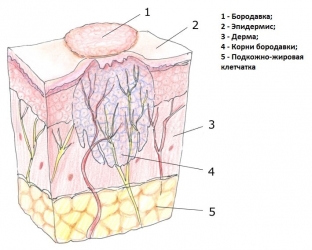Anogenital warts are skin lesions caused by the human papillomavirus. Most often they appear due to the activation of those types of the virus that have a low oncogenic risk, but in some cases, types of high oncogenicity can also be activated. The disease is sexually transmitted, but can lurk in the body for a very long time, so that clinical signs appear many years after infection. Timely treatment can provide a quite favorable prognosis for life.
Why and where do anogenital warts appear
Anogenital warts develop in men and women in the perianal region and on the genitals, and may take the form of spots, round papules and genital warts. The cause of the disease is the human papillomavirus, which is sexually transmitted. The manifestations of the disease, as well as the diagnosis, often cause severe stress in patients, and therefore the doctor’s careful work is required to clarify the situation:
- Firstly, most types of anogenital warts are caused by the activation of those types of papillomavirus that have a low oncogenic risk and do not pose a risk of turning into cancer with regular monitoring and necessary treatment, and only two rare species are caused by a more aggressive oncogenic type of virus, but and they can be treated;
- secondly, there is a fairly wide range of methods for treating anogenital warts, from which you can choose the most suitable for a particular patient, and despite the propensity of the disease to recur, it is quite possible to completely cure a few months after the start of therapy;
- thirdly, in monogamous relationships, the development of anogenital warts does not at all mean the presence of extraneous sexual relations in one of the partners, since infection with the human papillomavirus could have occurred many years ago, and the virus can be in a latent state for a long time. Anogenital warts
Anogenital warts usually appear in places where the skin and mucous membranes are often injured during sexual contact. Elements can be both single and multiple loose. In patients with diabetes mellitus and immunodeficiency, fusion of elements into plaques of different sizes can be observed.
Most often, anogenital warts are located on the genitals, affecting in men - the glans penis and foreskin, sometimes the scrotum and perineum; in women - large and small labia, the entrance and walls of the vagina, the cervix. In about 20% of cases in men, the external opening of the urethra is affected, in women this occurs in about 2% of cases. Those who practice anal sex are more likely to develop genital warts in the anus.
Clinically, the presence of anogenital warts can be manifested by hyperemia and burning, the appearance of cracks in the skin and mucous membranes, bloody discharge and pain during sexual contact.

Types of anogenital warts and their locations
Anogenital warts can appear as warts, papules, and spots. Separate mention is made of the rare Buschke-Lovenshtein giant condyloma and intraepithelial neoplasia - these types of anogenital warts are characterized by growth in the depth of the mucous membrane.
Condylomas protrude above the surface of the mucous membranes of the genital area, look like non-painful finger-like elements with a diameter of up to 10 mm.
Warts often affect the skin of the anogenital zone, have hyperkeratosis, pronounced pigmentation, the same size as condylomas.
Spots of anogenital warts occur on the mucous membrane of the genitals, their color ranges from gray to pink and brown, the number is from one to many.
We note that anogenital warts disturb patients both as a cosmetic defect, and as a painful element that interferes with a normal sexual life, and as a frightening factor in the likely development of oncological disease, therefore, the treatment of the disease should be carried out taking into account the psychological characteristics of the patient.






Add a comment